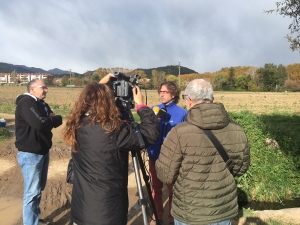During the last two years more than 4,500 juvenile Naiads have been released in the river basins of the Ter, Fluvià and Muga rivers
This action, made by the LIFE Project Potamo Fauna, have allowed to create 27 new locations and reinforce 15 other ones
Within the framework of the European project LIFE Potamo Fauna "Conservation of fluvial fauna of European interest in the Natura 2000 network of the river basins of the rivers Ter, Fluvià and Muga" (2014-2017) on November 6th, a press conference presented the results obtained in the recovery of populations of naiads of the species Unio mancus and Unio ravoisieri in the river basins of the rivers Ter, Fluvià, Brugent, Ser, Llémena, Xuncla and Riudelleques and the lake of Banyoles. Naiads are at risk of extinction in the medium term in those areas.
The main system used for recovering the naiads has been the reproduction in captivity and the release of juvenile specimens, older than two years, but also by releasing of fish infested with larvae, and also by releasing newborn juveniles and adult translocation. The objective of the project has been to create 2 to 4 new locations with naiads in each of the natural areas of the Natura 2000 network that participate in the project.
Stocks have been released in 42 different locations. 27 of them have been created again, in places where there were no naiads, and 15 of them have been reinforced with new ones, so the existing population will increase.
In total during 2016 and 2017, the whole area has been repopulated with 4,505 juveniles raised in captivity between the years 2011 and 2016, raised in the nursery breeding laboratory of the Consorci de l'Estany, located in Porqueres. Moreover, 747 wild adult and juvenile specimens have been translocated into new locations, 90,675 juveniles born in 2017 have been released and 3,950 fish have been infested with larvae, and then released. The small the naiads released, the less successful is the success. In the Natural Park of the Volcanic Zone of La Garrotxa, 1,345 juveniles raised over one year have been released, and also have 25,520 juveniles born in 2017 and 1,141 infested fish. Within the park 6 areas were repopulated, 3 of them where there were already a few naiads and 3 of them where new ones. The Natural Park was a pioneer in the breeding in captivity of naiads when in 1993 the "Study and Recovery Project for naiads in PNZVG" (called before Unio aleroni) was initiated.
On the other hand, more than 2,000 juveniles, of smaller sizes, are maintained in the breeding ground for breeding sites for the years to come in the post-LIFE plan.
In order to choose the stocking points, ecological criteria, the state of the populations and their distribution, the type of habitat and / or the presence of invaise species have been taken into account. Areas with a lot of Crayfish and exotic fish have been not used, also areas with a high effect of floods, and channels and stretches of rivers with well-vegetated rivers have been selected positively with the presence of woods and other forest trees from the bank and roots where the naiads find refuge.
The naiads
Naiads are freshwater bivalves, water mussels, which live half buried in the sediment and feed by filtering water particles. They are bio-indicator species of environments in good condition, and most are protected because they are in a vulnerable situation. In addition, they have a very peculiar life cycle, as larvae of the naiads need to parasitize a fish host to be able to live. Each species of naiads has certain fish species, usually native fish.
Its life cycle is very unique, presenting a parasitic phase of a fish. Females release microscopic larvae, called gloquids, which need to stick to the gills of a fish host to be able to develop and mature until they get the morphology of a juvenile. Fish do not suffer from the presence of larvae. Not all fish can be parasite with success. In the case of Unio genus naiads, local native fishes from the Ter and Fluvià basin are known as the Barbus meridionalis, the Squallus laietanus and the Salaria fluviatilis.
After 10-30 days, the larvae comes out of the fish and falls into the sediment where the juvenile grows up to its adult form, being reproductive individuals at the age of 4 years. The naiads have high longevities of up to 30 years when the conditions are appropriate.


















